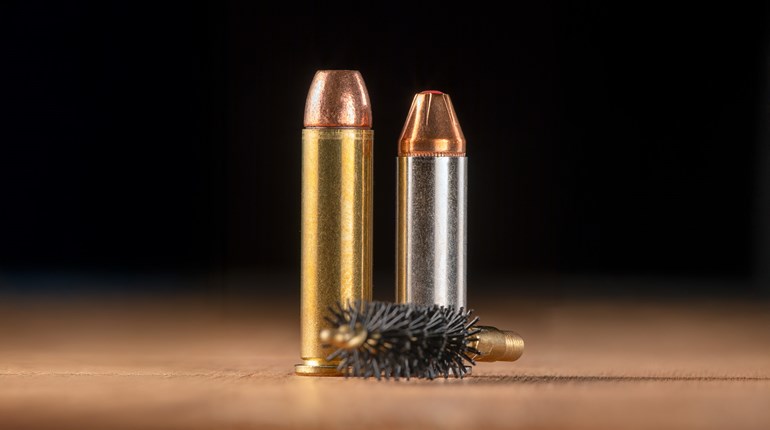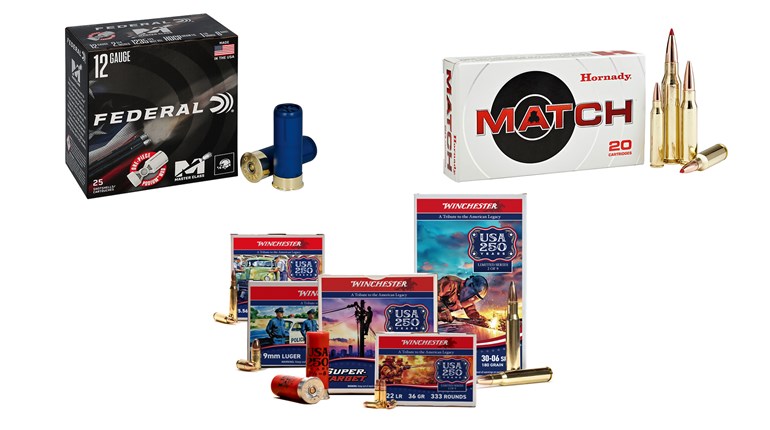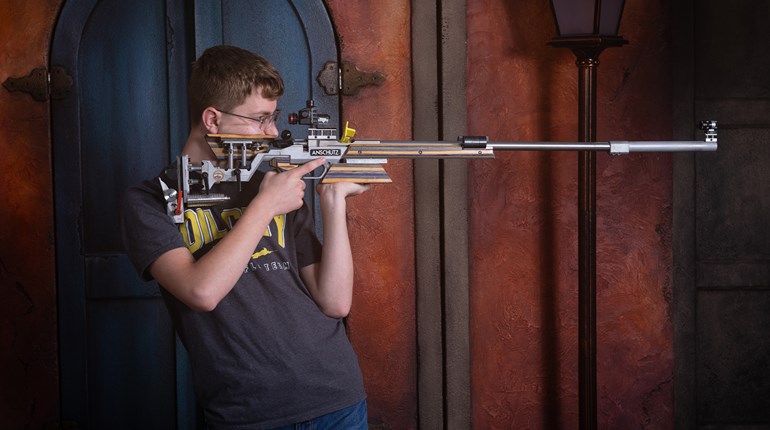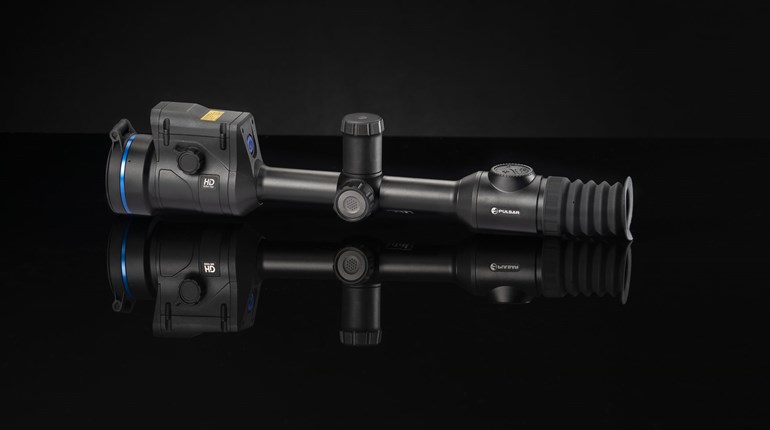
When conducting serious accuracy testing, use a sufficient number of shots on a paper target so the results reliably represent firearm and ammunition performance. Five-shot groups are often inadequate; as I previously demonstrated, group sizes can vary substantially from one five-shot string to another using the same ammo, so they may not accurately reflect typical accuracy.
A follow-up article looked at increasing the shot count all the way up to 50-shot groups. Even then, there can be different size groups with the same ammo.
Today I take a look at another statistic: how much group size increases as more shots are added. For this exercise, I fired a 50-shot group. Partway through the string, I measured the group size to see how much it would grow as the count reached 50 shots.
For the partway shot count, I considered the following: I wanted a shot count that a person might use if they were taking the whole accuracy-testing thing seriously. I selected 20 shots as a reasonable number. I figured it should be more than 10, and would reflect an intention to be a bit more rigorous. So, 20 it was.
Here was my procedure. I fired all 50 rounds on one target. But, after the first 21 shots (21? see below), I walked down range and measured the group size. Then I returned and shot the remaining 29. Thus the 21-shot group is from the same shots as the 50-shot group. This provides a chance to see how the 21-shot group size predicts the 50-shot group size.
Okay, but why 21 shots? What happened to 20? Why such an oddball number? It’s simple. My test gun was a 7-shot revolver, which means it was three full cylinders of ammo.
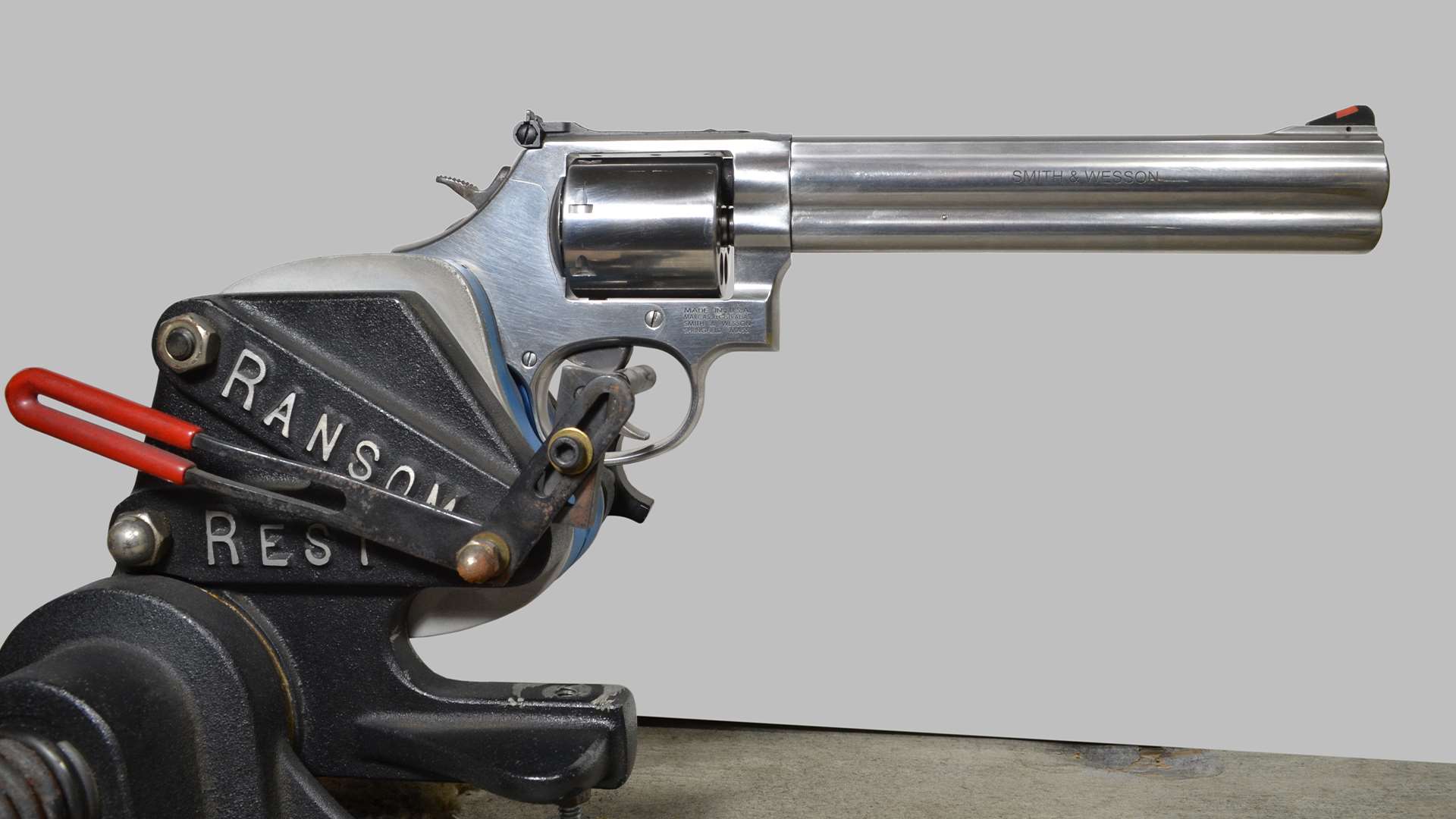
The gun was a 7-shot Smith & Wesson Model 686-Plus .357 Mag. revolver with a 7-inch barrel. It was placed in a Ransom Rest to remove the human variable. The target was at 25 yards.
The ammunition was .38 Spl. brass loaded with an ACME HiTek coated 148-grain double bevel base wadcutter cast bullet. They were seated sprue end up to an overall length of 1.235 inches. The gun likes this bullet, which makes it a good choice for an accuracy comparison. Starline brass was used with all loads. Primers were Federal 100M.
Twenty-seven 50-shot groups were fired with nine different powders, for a total of 1,350 rounds. Four loads were repeated to check for consistency of results. They are labeled with a “R” in the table.

RESULTS
The average 21-shot group size was 1.41 inches, and the average 50-shot group size was 1.77-inches. Thus, the 21-shot group size increased by an average of 25% by the end of 50 shots.
The range of the difference between the 21-shot group size and the 50-shot group size was variable, of course. In two cases (2.6 grains of Bullseye and 2.6 grains of Winchester Super Target - WST) the 21-shot group was the same size as the 50-shot group. These groups didn’t get larger after an additional 29 shots were fired, which is more than doubling the shot count.
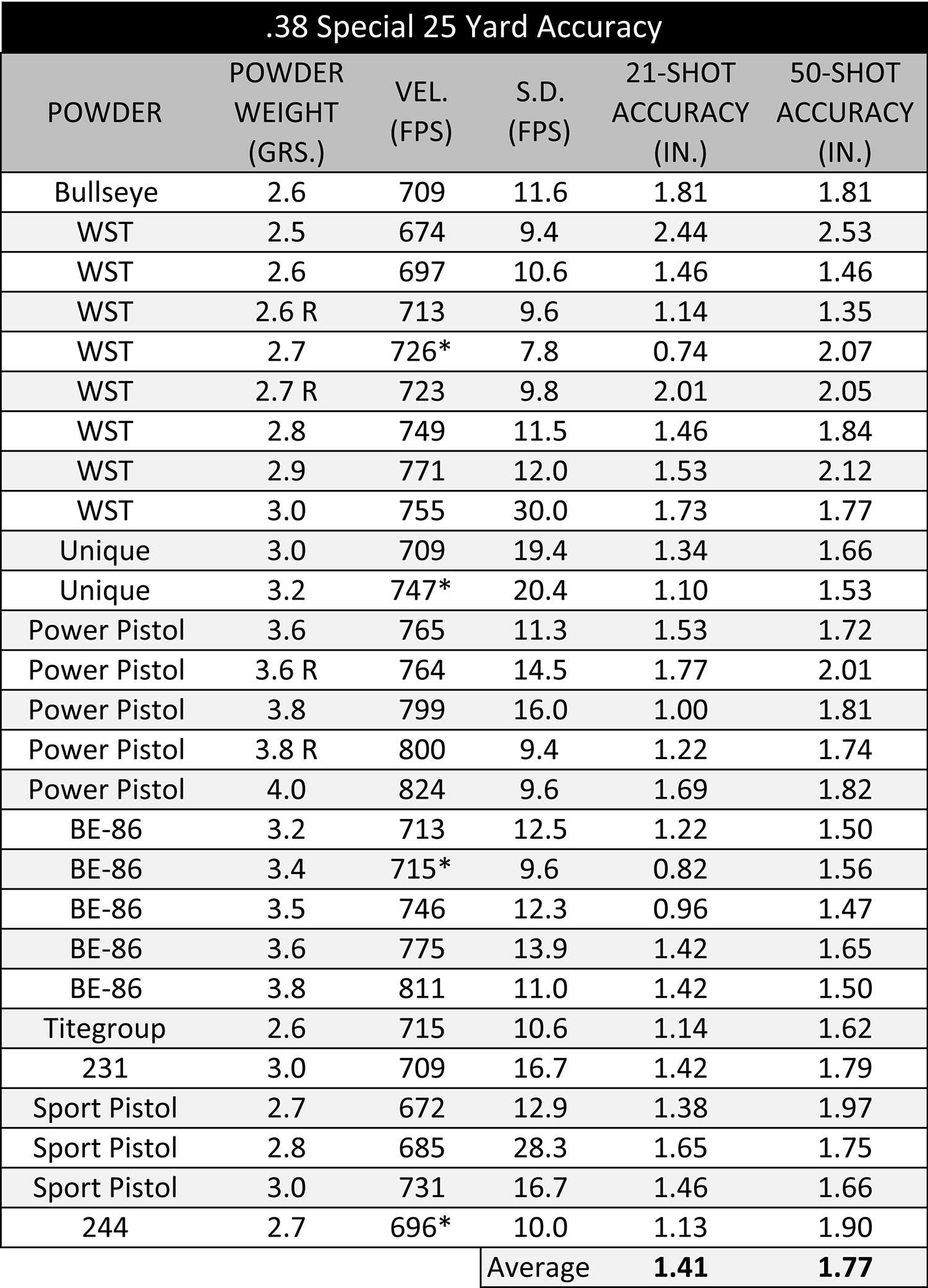
The smallest 21-shot group was just 36% of the size of the 50-shot group (2.7 grains of WST). That’s just barely over a third of the size of the final group. Three other examples of the small count being significantly smaller than the 50-shot group were at 53% (3.4 grains of BE-86), 55% (3.8 grains of Power Pistol) and 59% (2.7 grains of Winchester 244), so there was a chance that the 21-shot group was around half the size of the full 50-shot group.
A quick look with a correlation statistics test shows that the 21-shot group size is statistically significantly positively correlated with the 50-shot group size. That is, the larger the 21-shot group size, the larger the 50-shot group size, and conversely. For you statistics people, the correlation coefficient r was 0.56, which is a strong correlation for a sample size of 27. So, writing it like a scientist, r (25) = .56, p < .01, two-tailed. This is just a statistical way of saying that the 21-shot group has predictive power of the size of the 50-shot group.
But the predictive power is not perfect. In fact, the smallest 21-shot group ultimately ended up with one of the largest 50-shot groups. The smallest 21-shot group, produced with 2.7 grains of WST, was 0.74 inches. But the rest of the 29 shots opened it up to 2.07 inches, the third largest 50-shot group.
Four loads were repeated, two with WST (2.6 and 2.7 grains) and two with Power Pistol (3.6 and 3.8 grains). The loads with WST show just how variable the results can be.
The first load with 2.6 grains of WST produced a 1.46-inch 21-shot group, and it was the same size with 50-shots. The repeated firing shot a slightly smaller 21-shot group at 1.14 inches and the 50-shot size was 1.35 inches, the smallest of all the 27 loads tested. The two 50-shot groups were similar in size. These two loads with 2.6 grains of WST produced the two smallest measured 50-shot groups.
The first firing with 2.7 grains of WST produced the smallest 21-shot group at 0.74 inches. But the 50-shot group blew up to over two inches and ended up being the third largest. The second firing of this load produced one of the largest 21-shot groups, at 2.01 inches. But the 50-shot group was barely larger at 2.05 inches. This is a good example of the variable predictability of the lesser-count group to predict the size of the larger-count group. The 50-shot groups of both the 2.7 grain WST loads were nearly identical, at 2.05 and 2.07 inches. Mighty consistent!
The other two repeated loads, using Power Pistol, had more similar group sizes with 21 shots, with the same powder charge pairs differing by just a bit over .20 inches. The loads with 3.8 grains made smaller 21-shot groups than the loads with 3.6 grains. The 50-shot pairs were also similar, with the greatest difference being .29-inches between the two loads with 3.6 grains of powder. The 3.8-grain loads had a larger increase in group size from the 21- to 50-shot groups than the 3.6-grain loads, but they were not ground-shaking, so I’ll just label them as reasonably consistent. The 50-shot groups with both charge weights were similar enough that neither was clearly better than the other in my gun.
This discussion would not be complete if I didn’t talk about the bullet and powders. My revolver likes this bullet, but I was selective in picking which ones to shoot. Cast bullets are subject to casting flaws such as pinholes and wrinkles caused by the molten lead not perfectly filling the mold. I inspected every bullet and excluded any with observable flaws.
I did not do an exhaustive test of commonly used powders. For example, I include only one load with Bullseye. My other data show that Bullseye shoots wadcutters well in this gun, but some other powders can equal or exceed what Bullseye does, so I used a variety of powders to test their suitability as a mild wadcutter powder. This comparison was eclectic, and I wanted to test some powders I had not used before.
Results from a couple of powders are worth noting. WST, a powder well known for its excellent performance with wadcutters, produced variable 50-shot group sizes. The two smallest 50-shot groups at 1.35 and 1.46 inches were with WST and the same powder charge weight, 2.6 grains. But results with WST were not consistent. In this gun, with this bullet, WST had a very narrow working range for the best results—just the 2.6-grain weight.
Other charge weights produced larger groups, including the 2.5 grain charge that produced the largest group of 2.53 inches. In fact, WST produced the four largest 50-shot groups, all more than 2.0 inches. It shows the fickle nature of powders in some guns, where these results show the same powder produced the smallest and largest group sizes. It reinforces why you must test multiple loads to see how your gun likes them, because the differences can be significant.
Several powders produced some nice 50-shot groups. The results with Unique, with groups measuring 1.66 and 1.53 inches show that this powder worked well with this bullet in my gun.
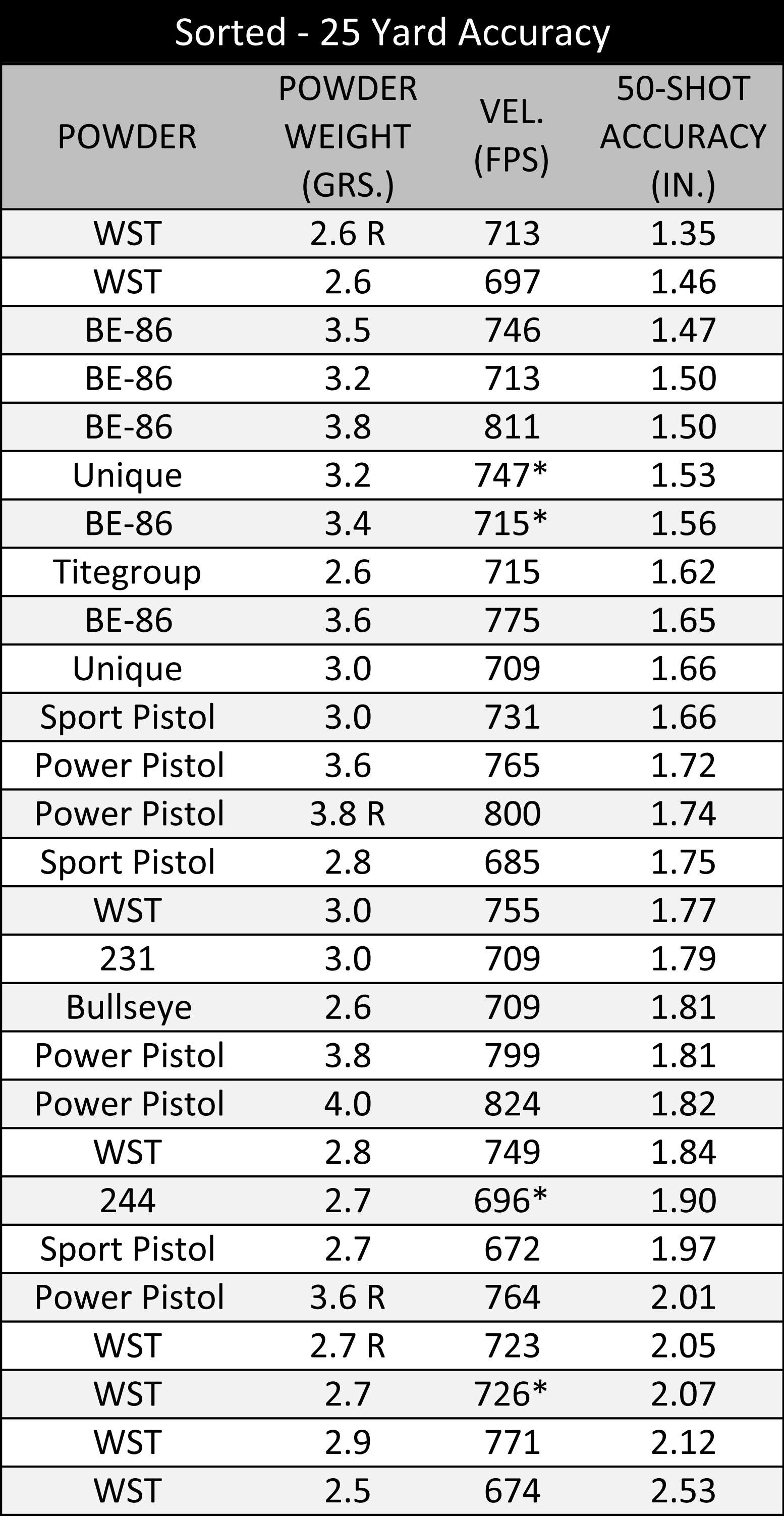
One powder that stood out was Alliant BE-86. It consistently produced small groups with five different charge weights tested, which covered a range of 100 fps. Its smallest 50-shot group was 1.47 inches, and its largest was 1.65 inches, with an average of 1.54 inches. BE-86’s burn rate is right between Unique (faster) and Power Pistol (slower). These burn rates are a little slow for low pressure loads typically produced with wadcutters at low speed. As a result, these powders don’t burn very clean, and can leave visible debris in the chambers and barrels. While this did not affect accuracy, the debris can sometimes impede chambering the next round, and in rare cases, get under the extractor star and jam the gun. If you’re casually plinking, this is a minor inconvenience, but if you’re shooting in a match where your stage has a time limit, this can ruin your day. I mention this because I did have occasional issues with unburned powder debris during my tests.
It’s important to point out that the size difference between some of the groups was really small, being just fractions of an inch, and realistically, might be meaningless for most shooters. While differences in tenths of an inch might seem significant to our eye when listed in the table, e.g., 1.6 is clearly smaller than 1.8, it’s just two-tenths of an inch difference, and at a distance of 25 yards. So, keep that in mind when looking at the table.
SUMMARY
The results reported here with my gun and ammo show that group size increased an average of 25% going from a 21-shot group to a 50-shot group. You can imagine that with a smaller round count, like five shots, those average groups would be smaller and there would be a larger increase in average group size to achieve the 50-shot size.
What is the meaningfulness of a 25% increase? More than doubling the number of shots (21 shots plus 29 more) produced only a 25% average increase in group size. Average group size didn’t double, so increasing by 25% doesn’t seem like that much. Of course, if you look at individual examples, group size nearly tripled for one load—the WST 2.7 grains went from .74 inches to 2.07 inches (a 2.8X increase), and nearly doubled for a couple of other loads. At the same time, some groups didn’t grow at all. But the overall average of a 25% increase suggests that group size generally grows only a moderate amount after you get to a reasonable shot count, in this case 21 shots.
This is just one set of data, but it raises awareness on a subject that is not often discussed, which is how much might group size increase if more shots are fired. Looking at group size data like this broadens our perspective of what we should consider when comparing numbers. First, shooting all your test rounds into one group lets you see the bigger picture of your gun’s accuracy. Second, more shots on the target get you closer to assessing the gun’s precision. Even with what some would consider a reasonable number of shots on their target, for example, 21 shots, there will be variability in its power to predict what more shots will look like. More shots might increase group size considerably (small groups happen by chance), or not at all (the first few shots are as wide as the remaining shots will be).
Accuracy testing is always a bit of a crap shoot, but knowing the strengths and limitations of your round count makes you a more insightful shooter.













